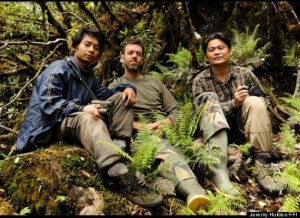More On New Northern Burmese Cryptid Primate
Posted by: Loren Coleman on January 13th, 2012

Kerinci Seblat National Park, Jambi, Sumatra: National Geographic’s Beast Hunter Pat Spain and Jeremey Holden head up into the forest towards a crater lake called Gunung Tujuh to look for signs of Orang Pendek. Photo Credit: Icon Films.
The two most well-known Western researchers to have attempted to document Orang Pendek is a British journalist-turned-conservationist Debbie Martyr and a British photographer Jeremy Holden. Debbie and Jeremy have engaged in a nearly 20-year project beginning in the late 1980s and funded since the 1990s by Fauna and Flora International. The scope of the project was to systematically document eyewitness accounts of the animal and to obtain photographic proof of its existence via camera-trapping methods. Debbie and Jeremy did not succeed in scientifically confirming its existence yet (Martyr has since moved on to head TNKS’s Tiger Protection and Conservation Unit), but they collected several footprint casts that appear to be from Orang Pendek and claim to have personally seen the animal on several occasions while working in the forest.
One of the side benefits of looking for the Orang Pendek has been the discovery of other new species.
Holden, who was responsible for supporting and installing several of the teams in that region trying to verify new species, including the new Myanmar snub-nosed monkey, writes me: “We are in the process of describing a new snake and a strange chubby skink, and have other stuff waiting description.”

Jeremy Holden with his team that photographed the first living Myanmar snub-nosed monkeys (Rhinopithecus strykeri).
Has he heard anything about the possible new new northern primate noted by Lee Speigel in yesterday’s Huffington Post?

Jeremy Holden adds this:
“Interestingly, the Burmese locals talk about a very similar thing in the far north. I remember hearing stories from Assam, too, many years ago – both of which sound more like OP [Orang Pendek] than other larger homonoids described from the mainland and Himalayas. No evidence to go on except stories, though.”
About Loren Coleman
Loren Coleman is one of the world’s leading cryptozoologists, some say “the” leading living cryptozoologist. Certainly, he is acknowledged as the current living American researcher and writer who has most popularized cryptozoology in the late 20th and early 21st centuries.
Starting his fieldwork and investigations in 1960, after traveling and trekking extensively in pursuit of cryptozoological mysteries, Coleman began writing to share his experiences in 1969. An honorary member of Ivan T. Sanderson’s Society for the Investigation of the Unexplained in the 1970s, Coleman has been bestowed with similar honorary memberships of the North Idaho College Cryptozoology Club in 1983, and in subsequent years, that of the British Columbia Scientific Cryptozoology Club, CryptoSafari International, and other international organizations. He was also a Life Member and Benefactor of the International Society of Cryptozoology (now-defunct).
Loren Coleman’s daily blog, as a member of the Cryptomundo Team, served as an ongoing avenue of communication for the ever-growing body of cryptozoo news from 2005 through 2013. He returned as an infrequent contributor beginning Halloween week of 2015.
Coleman is the founder in 2003, and current director of the International Cryptozoology Museum in Portland, Maine.










Whether it’s Orang Pendek or another primate (or any mammal, for that matter) a new species is a new species. Sure it would be fabulous to flesh out the primate family tree a bit more and to prove that large primates can survive without being seen or caught but anything new is another mark in the win column, especially if it adds more pressure to keep the forests standing and pristine.
I have a feeling that enough companies and/or countries would be willing to pay a fee to any country with rare wildlife to keep the forests intact as a type of carbon offset. It’s good for their PR, it would probably be at least a partial tax credit in the Western world and it might prevent some of the developing nations from making the same environmental mistakes that we have.